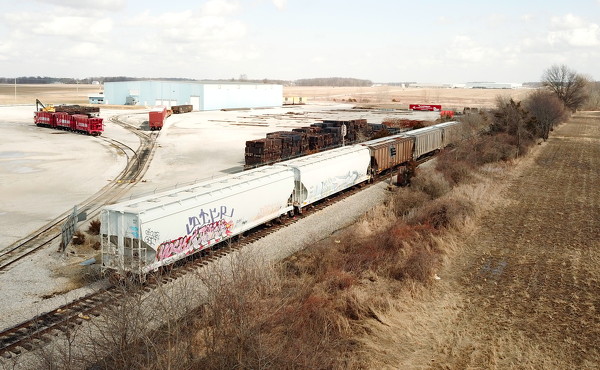
Train cars are parked on railroad tracks near the R.J. Corman facility between St. Marys and Celina.
By WILLIAM KINCAID and BOB TOMASZEWSKI
wkincaid@dailystandard.com
CELINA - In addition to relatively innocuous freight, hazardous materials are transported by trains on railroads in the area, according to local emergency management agency directors.
Neither Mercer County EMA Director Mike Robbins nor his Auglaize County counterpart, Troy Anderson, have had to deal with hazardous spills resulting from train derailments like the one in East Palestine.
"We've had some vehicle-train accidents where a vehicle tried to beat the train … but I'm not aware of them even derailing the train at those points," said Robbins, who started with the agency in 2003 before being named director in 2011.
Train derailments have happened in Auglaize County but none of the cars were hauling hazardous materials, Anderson said.
"We've had them derail by a vehicle hitting a car," he said. "We always do the 'what if?' and hope that it never happens. The best plan is a plan that never has to be activated."
But both agencies have plans in place should toxic chemicals escape the confines of a train car into the environment.
In Auglaize County train cars that roll through generally carry automobiles, grain, lumber, steel and rubber, according to Anderson.
"Then we also have a hazardous materials train that can carry a blend of chemicals from styrene to chlorine to hydrochloric acid, to ammonia and propane," Anderson said. "We have hazardous chemicals and extremely hazardous chemicals."
Most of the commodities moved by trains in Auglaize County are on either the CSX Transportation line, which runs through Wapakoneta, or the Indiana & Ohio Railway line in the Uniopolis area. Anderson said the R.J. Corman line sees less commodities activity.

A railroad intersects with Warren Street in Celina.
Mercer County has at least one active rail line, Robbins said.
"There used to be several but I think it's just the one that goes through Celina and ends up close to the state line and Fort Recovery," he said.
As to hazardous materials shipped by rail in Mercer County, Robbins said, "The only thing I'm aware of is they will at times transport anhydrous ammonia."
Hazardous material spills occur from time to time in Mercer County, usually involving diesel fuel released during truck accidents. In October 2012, a portion of State Route 49 had to be shut down between Tama and Schaadt roads near Chattanooga as workers cleaned up a large fuel spill following a three-vehicle accident. A tanker overturned on the highway, spilling 5,000 gallons of diesel.
"We've had some bigger stuff here but luckily not very often. And that (tanker leak) was out in the middle of nowhere basically, no even a house close, just a field," he said.
However, the response to a train derailment related spill would be similar.
"The hazmat plan's actually an annex to the county emergency operations plan," Robbins said. "Traffic control's traffic control whether it's for hazmat, debris from a tornado or flooding."
"Every county is required to have the hazmat plan," Anderson said.
Along with a response coordinated among fire and police departments, emergency medical service providers, sheriff's office and other county departments, state and federal agencies may mobilize resources and assets.
"The rail line is federal," Anderson said. "They have their own federal police department."
"My first call would be to Ohio EPA and Ohio EMA," Robbins said. "Ohio EMA would be the real authority."
Ohio EPA, Robbins noted, has air and water monitoring capabilities.
A third party would be contracted to clean up the actual spill.
"There's companies that all they do is clean up hazardous material spills," Robbins said.
Anderson also pointed out the chemical manufacturer would be involved and structural engineers and other experts consulted depending on the nature of the incident.
"The experts involved are the ones we are getting the information from, and that way it doesn't create a bigger problem," Anderson said.
Officials would decide whether it's safer to burn a spilled chemical or chose another course of remediation, such as pumping. They would also consider the possibility of water contamination.
"If you get it hot enough it burns off all the chemicals and then all you have is the soot," Anderson said.

A railroad intersects with Ash Street in Celina.
EMAs carry out yearly hazardous material exercises.
Last May, scores of firefighters, cops and other responders rushed to Coldwater Memorial Park on a Saturday morning on calls of a hazardous chemical release resulting in injuries and medical conditions.
It was only an exercise but emergency responders treated it like the real deal, followed proper procedures and tended to a handful of children who played the part of victims.
Roughly 50 people took part in the staged event that involved Mercer Health Community Hospital; Coldwater fire and police departments and emergency medical services branch; St. Henry fire and police departments; Mercer County EMA; medical reserve corps; health district; and emergency response volunteers.
The scenario that unfolded involved a simulation of a delivery truck with an unsecured load. A mock cylinder of chlorine fell off the truck, resulting in a small leak of chlorine.
Responders set up a decontamination line consisting of hoses, baby pools and showers. Children with simulated medical conditions and responders who came in close contact with the mock chlorine were processed through the line.
Once decontaminated, those with simulated conditions were transported by squad to the hospital. No lights or sirens were activated.
Firefighters in Mercer County are skilled and well-trained, Robbins said.
"Our fire departments - we only have one paid department, the rest are volunteer - they train constantly. Most of them train at least weekly if not monthly," Robbins said. "The Celina fire guys, they train every shift."
He also said emergency responders work well together in Mercer County.
"Mercer County response and government agencies have shown, though many situations, great cooperation and communications with each other for the good of the citizens of Mercer County," Robbins said.

